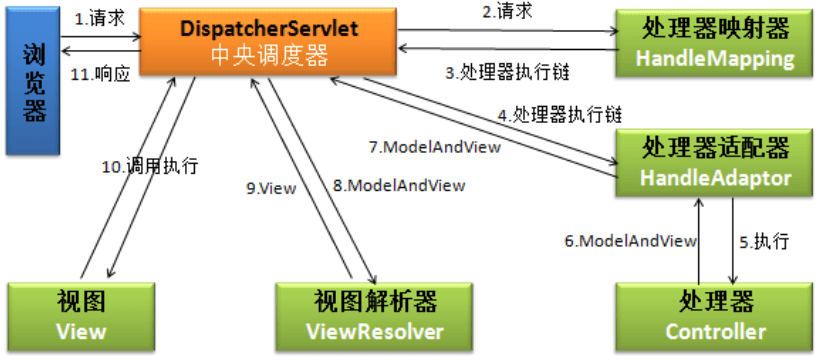springboot(六)——springboot與webflux結合初探
這幾天看了看spring-cloud-gateway的請求處理流程,因爲之前一直用的springboot1.x和spring4,一開始對spring-cloud-gateway的處理流程有點懵逼,找不到入口,後來跟了代碼,在網上找了點資料,發現spring-cloud-gateway的入口在ReactorHttpHandlerAdapter的apply方法
public class ReactorHttpHandlerAdapter implements BiFunction<HttpServerRequest, HttpServerResponse, Mono<Void>> {
private static final Log logger = HttpLogging.forLogName(ReactorHttpHandlerAdapter.class);
private final HttpHandler httpHandler;
public ReactorHttpHandlerAdapter(HttpHandler httpHandler) {
Assert.notNull(httpHandler, "HttpHandler must not be null");
this.httpHandler = httpHandler;
}
@Override
public Mono<Void> apply(HttpServerRequest reactorRequest, HttpServerResponse reactorResponse) {
NettyDataBufferFactory bufferFactory = new NettyDataBufferFactory(reactorResponse.alloc());
try {
ReactorServerHttpRequest request = new ReactorServerHttpRequest(reactorRequest, bufferFactory);
ServerHttpResponse response = new ReactorServerHttpResponse(reactorResponse, bufferFactory);
if (request.getMethod() == HttpMethod.HEAD) {
response = new HttpHeadResponseDecorator(response);
}
return this.httpHandler.handle(request, response)
.doOnError(ex -> logger.trace(request.getLogPrefix() + "Failed to complete: " + ex.getMessage()))
.doOnSuccess(aVoid -> logger.trace(request.getLogPrefix() + "Handling completed"));
}
catch (URISyntaxException ex) {
if (logger.isDebugEnabled()) {
logger.debug("Failed to get request URI: " + ex.getMessage());
}
reactorResponse.status(HttpResponseStatus.BAD_REQUEST);
return Mono.empty();
}
}
}
該方法的作用就是把接收到的HttpServerRequest或者最終需要返回的HttpServerResponse,包裝轉換爲ReactorServerHttpRequest和ReactorServerHttpResponse。
spring-webflux
當然,這篇文章的主要內容不是談論spring-cloud-gateway了,因爲之前一直用的spring4,所以對spring5當中的反應式編程範式和webflux不太瞭解,所以先寫個demo瞭解一下
第一步:引入相關pom,測試的相關pom根據自己的需要引入
<parent>
<groupId>org.springframework.boot</groupId>
<artifactId>spring-boot-starter-parent</artifactId>
<version>2.1.4.RELEASE</version>
<relativePath/> <!-- lookup parent from repository -->
</parent>
<dependencies>
<dependency>
<groupId>org.springframework.boot</groupId>
<artifactId>spring-boot-starter-webflux</artifactId>
</dependency>
<dependency>
<groupId>org.springframework.boot</groupId>
<artifactId>spring-boot-starter-test</artifactId>
<scope>test</scope>
</dependency>
<dependency>
<groupId>io.projectreactor</groupId>
<artifactId>reactor-test</artifactId>
<scope>test</scope>
</dependency>
</dependencies>
第二步:創建一個HandlerFunction
public class TestFunction implements HandlerFunction<ServerResponse> {
@Override
public Mono<ServerResponse> handle(ServerRequest serverRequest) {
return ServerResponse.ok().body(
Mono.just(parse(serverRequest, "args1") + parse(serverRequest, "args2"))
, Integer.class);
}
private int parse(final ServerRequest request, final String param) {
return Integer.parseInt(request.queryParam(param).orElse("0"));
}
}
第三步:注入一個RouterFunction
@Configuration
public class TestRouteFunction {
@Bean
public RouterFunction<ServerResponse> routerFunction() {
return RouterFunctions.route(RequestPredicates.GET("/add"), new TestFunction());
}
}
第四步:在webflux中,也可以使用之前的java註解的編程方式,我們也創建一個controller
@RestController
@RequestMapping("/api/test")
public class HelloController {
@RequestMapping("/hello")
public Mono<String> hello() {
return Mono.just("hello world");
}
}
第五步:創建啓動類
@SpringBootApplication
public class Spring5DemoApplication {
public static void main(String[] args) {
SpringApplication.run(Spring5DemoApplication.class, args);
}
}
第六步:啓動項目,訪問如下兩個接口都可以
http://localhost:8080/api/test/hello http://localhost:8080/add?args1=2&args2=3
和spring-boot結合
通過上面的例子,我們看到基本的兩個類:HandlerFunction和RouterFunction,同時webflux有如下特性:
- 異步非阻塞
- 響應式(reactive)函數編程,純lambda表達式
-
不僅僅是在Servlet容器中tomcat/jetty中運行,同時支持NIO的Netty和Undertow中,實際項目中,我們往往與spring-boot項目結合,我們跟進代碼可以看看spring-boot是在什麼時候創建的server
一、SpringApplicationpublic ConfigurableApplicationContext run(String... args) { StopWatch stopWatch = new StopWatch(); stopWatch.start(); ConfigurableApplicationContext context = null; Collection<SpringBootExceptionReporter> exceptionReporters = new ArrayList<>(); configureHeadlessProperty(); SpringApplicationRunListeners listeners = getRunListeners(args); listeners.starting(); try { ApplicationArguments applicationArguments = new DefaultApplicationArguments( args); ConfigurableEnvironment environment = prepareEnvironment(listeners, applicationArguments); configureIgnoreBeanInfo(environment); Banner printedBanner = printBanner(environment); context = createApplicationContext(); exceptionReporters = getSpringFactoriesInstances( SpringBootExceptionReporter.class, new Class[] { ConfigurableApplicationContext.class }, context); prepareContext(context, environment, listeners, applicationArguments, printedBanner); refreshContext(context); afterRefresh(context, applicationArguments); stopWatch.stop(); if (this.logStartupInfo) { new StartupInfoLogger(this.mainApplicationClass) .logStarted(getApplicationLog(), stopWatch); } listeners.started(context); callRunners(context, applicationArguments); } catch (Throwable ex) { handleRunFailure(context, ex, exceptionReporters, listeners); throw new IllegalStateException(ex); } try { listeners.running(context); } catch (Throwable ex) { handleRunFailure(context, ex, exceptionReporters, null); throw new IllegalStateException(ex); } return context; }
我們只分析入口,其它代碼暫時不管,找到refreshContext(context);這一行進去
二、ReactiveWebServerApplicationContext的refresh()
@Override
public final void refresh() throws BeansException, IllegalStateException {
try {
super.refresh();
}
catch (RuntimeException ex) {
stopAndReleaseReactiveWebServer();
throw ex;
}
}
三、ReactiveWebServerApplicationContext的onRefresh()
@Override
protected void onRefresh() {
super.onRefresh();
try {
createWebServer();
}
catch (Throwable ex) {
throw new ApplicationContextException("Unable to start reactive web server",
ex);
}
}
四、看到這裏我們就找到入口方法了:createWebServer(),跟進去,找到NettyReactiveWebServerFactory中創建webserver
@Override
public WebServer getWebServer(HttpHandler httpHandler) {
HttpServer httpServer = createHttpServer();
ReactorHttpHandlerAdapter handlerAdapter = new ReactorHttpHandlerAdapter(
httpHandler);
return new NettyWebServer(httpServer, handlerAdapter, this.lifecycleTimeout);
}
看到ReactorHttpHandlerAdapter這個類想必特別親切,在開篇說過是spring-cloud-gateway的入口,createHttpServer方法的細節暫時沒有去學習了,後續有時間去深入瞭解下
結語
spring5的相關新特性也是在學習中,這一篇文章算是和springboot結合的入門吧,後續有時間再深入學習













